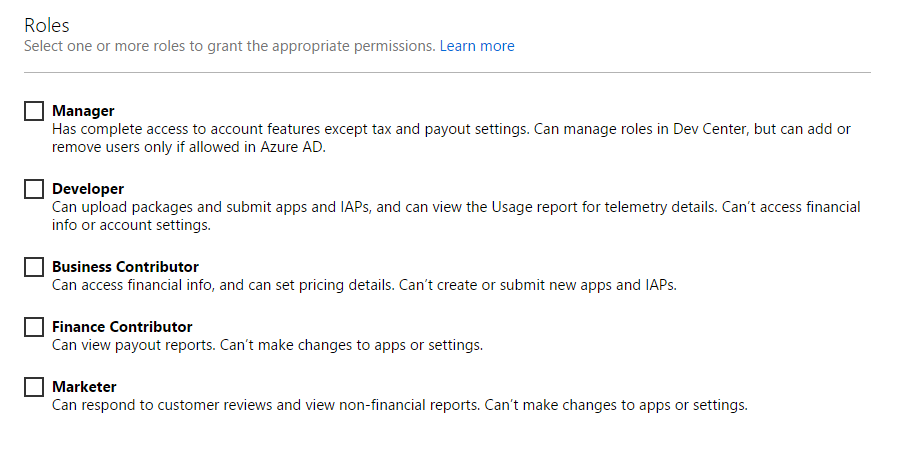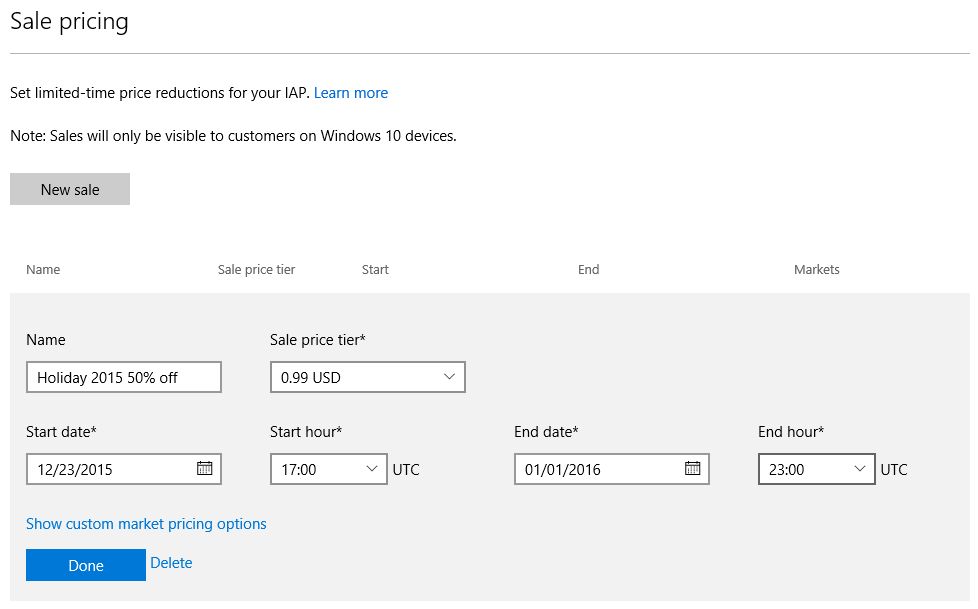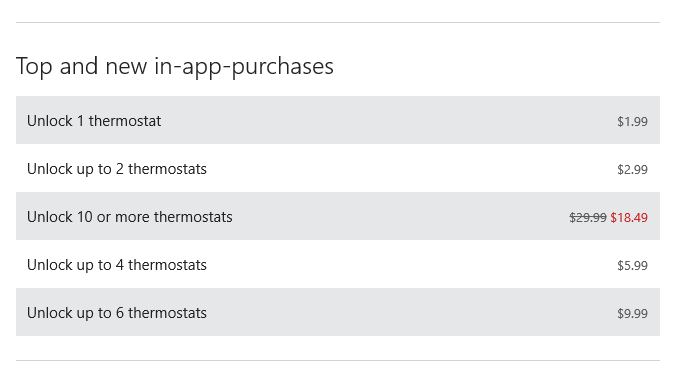- Multi-user access with roles: support multiple users in a single account, with permissions controlled through user roles – this is one of the most voted for features in user voice, and is available now in all Dev Center accounts
- Windows Store APIs: validate apps or in-app product acquisitions, useful for cross-platform services, or to add another layer of validation for customer purchases
- In-app purchase discounts: schedule IAP price discounts for apps running on Windows 10
- Access to Office and Azure programs: access the Office and Azure developer programs at no extra cost through the Dev Center registration
- More effective Store lists: The Store is updating the algorithms for the “New and Rising” and “Best Rated” lists to be able to show more apps than before
- Update to the Windows App Certification Kit: with additional validation tests for UWP app submissions
1. Multi-user access with roles
This week’s release includes one of the most requested features in Dev Center: support for multiple users in a single Dev Center account with the ability to assign the roles and capabilities of each user. This feature enables much greater account management flexibility with different permissions through managed roles:

Roles allow you to, among other things, choose which users can manage and submit packages, restrict access to account financial information, or allow only select users to be able to respond to reviews.
This new capability requires an Azure Active Directory (Azure AD) account with admin permissions to create and manage accounts. If you aren’t familiar with Azure Active Directory, you can read all the details and how-to guides.
2. Windows Store purchase and collection APIs
This month, Dev Center released two REST APIs for Windows Store services that unlock new scenarios never before possible in the Windows Store:
- Windows Store collection API: used to query if the app or IAP has been acquired, as well as to report a consumable IAP has been fulfilled
- Windows Store purchase API: used to grant ownership of a free app or free IAP
These new APIs enable you to directly access Windows Store ownership information for paid apps and IAPs from your services, giving you more control over purchase security. These APIs use Azure Active Directory (Azure AD) and enable advanced app scenarios, for example:
- Additional layer of fraud protection: when a user opens a paid app or attempts to use an IAP, the publisher can check with the service (directly or through the publisher servers) to verify that the user actually purchased that item before granting access in the app.
- Support for cross-platform services: if a user purchases an IAP in a Windows Store app, the publisher can confirm the user owns that app or IAP, and then enable that same feature in the same app in another platform, or on the Web.
I suggest you read more about how to use these API services.
3. In-app purchase sale pricing
The holidays are a great time to encourage users to purchase IAPs through discounted pricing. You can now schedule a sale for your IAPs. Just like app sales, when you publish a sale for an IAP, the price will drop at the start date and time you specify, and will automatically revert to the original price at the end date and time. You can configure sales with a duration of up to 30 days.
To schedule a sale in Dev Center, go to the Pricing and Availability page in an IAP submission, and select “Sale Pricing.” Give your sale a name (optional, not displayed to customers), then set the sale price, start date/time and end date/time, click or tap “Save,” to submit the IAP to the Store. You can also configure per-market pricing for your IAP sales.

Sales prices will only be visible to Windows 10 customers. If you use the Dev Center IAP Sale Pricing feature, customers running Windows 8.x or Windows Phone 8.x will not see any discount. If you want your Windows 8.x or Windows Phone 8.x customers to receive the discounted IAP, you’ll need to lower the base price, and revert it when you want the discount to end.
When you put an IAP on sale, Windows 10 customers will see the sale price in the purchase screen from the start to end date of the sale. Customers running the Windows 10 November update will also see the IAP on your app description page in the Store, with the original price in strikethrough and the sale price highlighted.

4. One registration for Windows Dev Center + Azure + Office
Developers with a Windows Dev Center account or those signing up for a new account can also access the Azure Marketplace and Office Store developer programs for no additional fee.
This allows you to access Azure services and Office add-ins developer portals; Windows apps are still managed separately (the same way they are managed today, in their own Dev Centers). Payouts for Azure and Office developers are managed separately at this time as well, with the plan to merge the payout process in a future release.
5. More effective Store lists for customers
The Windows Store has updated the algorithm used to select apps for the “Best Rated” and the “New and Rising” lists.
- Previously, the “Best Rated” apps and games list algorithm was based on ratings that the app received from all device families (Desktop/Tablet or Mobile). This update separates the ratings by device, so customers will see a more accurate app rating, based only on ratings created in that device family

- When customers browse through a specific category in the Store, a “New and Rising” list highlights the apps and games recently added in that category. Previously, the algorithm limited the number of apps eligible to be shown. This update allows more apps to be shown, providing increased visibility and opportunity to more developers.
6. Updated Windows App Certification Kit
Finally, a new Windows App Certification Kit was released this month, including additional Universal Windows Platform tests. The update also addresses an issue to correctly validate app resources like image sizes. The Windows App Certification Kit will detect and warn if it finds these problems in your app, and beginning in February, 2016 these errors will fail an app submissions. To avoid any potential issues, please download and install the latest version of the Windows App Certification Kit and use it to validate your UWP submissions. Learn more from Windows App Certification Kit and the new tests.
Feedback
This month Dev Center has released some major improvements, including multi-user access with roles, Windows Store APIs, and more opportunities to promote apps through IAP discounts and more effective Store lists.
We are looking for feedback, so as you use these features, please let us know about your experience through the “Feedback” button in Dev Center (found in the bottom right) or vote for new features through User Voice.
